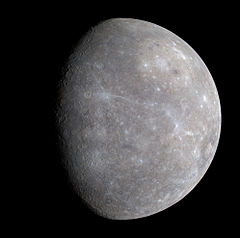Mẹ́rkúríù (pálánẹ́tì)
 MESSENGER false color image of Mercury |
||||||||||
Ìfúnlọ́rúkọ
| ||||||||||
|---|---|---|---|---|---|---|---|---|---|---|
| Ìpolongo | /ˈmɜrkjəri/ ( |
|||||||||
| Alápèjúwe | Mercurian, Mercurial[1] | |||||||||
Àwọn ìhùwà ìgbàyípo[2]
| ||||||||||
| Àsìkò J2000 | ||||||||||
| Aphelion | 69,816,900 km 0.466 697 AU |
|||||||||
| Perihelion | 46,001,200 km 0.307 499 AU |
|||||||||
| Semi-major axis | 57,909,100 km 0.387 098 AU |
|||||||||
| Eccentricity | 0.205 630[3] | |||||||||
| Àsìkò ìgbàyípo | 87.969 1 d (0.240 846 a) 0.5 Mercury solar day |
|||||||||
| Synodic period | 115.88 d[3] | |||||||||
| Average orbital speed | 47.87 km/s[3] | |||||||||
| Mean anomaly | 174.796° | |||||||||
| Inclination | 7.005° to Ecliptic 3.38° to Sun’s equator 6.34° to Invariable plane[4] |
|||||||||
| Longitude of ascending node | 48.331° | |||||||||
| Argument of perihelion | 29.124° | |||||||||
| Satellites | None | |||||||||
Àwọn ìhùwà àdánidá
| ||||||||||
| Iyeìdáméjì ìfẹ̀kiri | 2,439.7 ± 1.0 km[5][6] 0.3829 Earths |
|||||||||
| Flattening | 0[6] | |||||||||
| Ààlà ojúde | 7.48 × 107 km²[5] 0.147 Earths |
|||||||||
| Ìpọ̀sí | 6.083 × 1010 km³[5] 0.056 Earths |
|||||||||
| Àkójọ | 3.3022 × 1023 kg[5] 0.055 Earths |
|||||||||
| Iyeìdáméjì ìṣùpọ̀ | 5.427 g/cm³[5] | |||||||||
| Equatorial surface gravity | 3.7 m/s² 0.38 g[5] |
|||||||||
| Escape velocity | 4.25 km/s[5] | |||||||||
| Sidereal rotationperiod | 58.646 day 1407.5 h[5] |
|||||||||
| Equatorial rotation velocity | 10.892 km/h (3.026 m/s) | |||||||||
| Axial tilt | 2.11′ ± 0.1′[7] | |||||||||
| North pole right ascension | 18 h 44 min 2 s 281.01°[3] |
|||||||||
| North pole declination | 61.45°[3] | |||||||||
| Albedo | 0.119 (bond) 0.106 (geom.)[3] |
|||||||||
| Ìgbónásí ojúde 0°N, 0°W 85°N, 0°W |
| |||||||||
| Apparent magnitude | −2.3 to 5.7[8][3] | |||||||||
| Angular diameter | 4.5" – 13"[3] | |||||||||
Afẹ́fẹ́àyíká
| ||||||||||
| Ìfúnpá ojúde | trace | |||||||||
| Ìkósínú | 42% Molecular oxygen 29.0% sodium 22.0% hydrogen 6.0% helium 0.5% potassium Trace amounts of argon, nitrogen, carbon dioxide, water vapor, xenon, krypton, & neon[3] |
|||||||||
Mẹ́rkúríù ni pálánẹ́tì to sunmojulo si Orun ninu Sistemu Orun, o unyipo Orun ni ekan ni 87.969 ojo Aye.

|
Àyọkà yìí tàbí apá rẹ̀ únfẹ́ àtúnṣe sí. Ẹ le fẹ̀ jù báyìí lọ tàbí kí ẹ ṣàtúnṣe rẹ̀ lọ́nà tí yíò mu kúnrẹ́rẹ́. Ẹ ran Wikipedia lọ́wọ́ láti fẹ̀ẹ́ jù báyìí lọ. |
Itokasi
- ↑ "mercurial". Merriam-Webster Online. Retrieved 2008-06-12.
- ↑ Yeomans, Donald K. (April 7, 2008). "HORIZONS System". NASA JPL. Retrieved 2008-04-07.
- ↑ 3.0 3.1 3.2 3.3 3.4 3.5 3.6 3.7 3.8 "Mercury Fact Sheet". NASA Goddard Space Flight Center. November 30, 2007. Retrieved 2008-05-28.
- ↑ "The MeanPlane (Invariable plane) of the Solar System passing through the barycenter". 2009-04-03. Archived from the original on 2009-04-20. Retrieved 2009-04-03. (produced with Solex 10 Archived 2015-05-24 at the Wayback Machine. written by Aldo Vitagliano; see also Invariable plane)
- ↑ 5.0 5.1 5.2 5.3 5.4 5.5 5.6 5.7 Munsell, Kirk (May 28, 2009). "Mercury: Facts & Figures". Solar System Exploration. NASA. Archived from the original on 2002-11-19. Retrieved 2008-04-07. Unknown parameter
|coauthors=ignored (|author=suggested) (help) - ↑ 6.0 6.1 Seidelmann, P. Kenneth; Archinal, B. A.; A’hearn, M. F.; et al. (2007). "Report of the IAU/IAGWorking Group on cartographic coordinates and rotational elements: 2006". Celestial Mechanics and Dynamical Astronomy 90: 155–180. doi:10.1007/s10569-007-9072-y. http://adsabs.harvard.edu/doi/10.1007/s10569-007-9072-y. Retrieved 2007-08-28.
- ↑ Margot, L.J.; Peale, S. J.; Jurgens, R. F.; Slade, M. A.; Holin, I. V. (2007). "Large Longitude Libration of Mercury Reveals a Molten Core". Science 316: 710–714. doi:10.1126/science.1140514. PMID 17478713. http://adsabs.harvard.edu/abs/2007Sci...316..710M.
- ↑ Cite warning:
<ref>tag with nameephemeriscannot be previewed because it is defined outside the current section or not defined at all.
